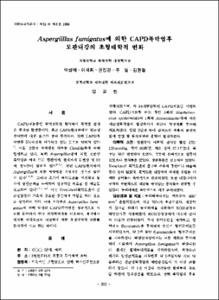KUMEL Repository
1. Journal Papers (연구논문)
1. School of Medicine (의과대학)
Dept. of Internal Medicine (내과학)
Aspergilllus fumigatus 에 의한 CAPD 복막염후 도관내강의 초형태학적 변화
- Alternative Author(s)
- Park, Sung Bae; Kim, Hyun Chul
- Journal Title
- 대한내과학회지
- ISSN
- 1226-329x
- Issued Date
- 1996
- Abstract
- Recently, dialysis-related fungal peritonitis have been increasingly reported, accounting for 5% of all cases of peritonitis. Most of these infections were caused by Candida species. Aspergillus species are an extremely rare cause of peritonitis in CAPD patients. Aspergillus peritonitis in CAPD patients have been fatal. We examined luminal surface of removed Tenckhoff peritoneal catheter in a patient on CAPD with Aspergillus peritonitis by scanning electron microscopy to study the morphology of fungal adherence.
A 53-year-old female with an end-stage renal disease and hypertension had been on CAPD for 14 months. The patient experienced sudden onset of fever, diffuse abdominal pain, and cloudy dialysate effluent. She was initially treated as an outpatient with intraperitoneal cefazoline and netilmicin. Three days later, there was no resolution of her symptoms and the patient was admitted. The dialysate effluent was cloudy with 468 leukocytes per mm3 and 70% segmented neutrophils. On the surface of inner lumen of the Tenckhoff peritoneal catheter numerous tiny small visible colonies were found. Dialysate samples were obtained for microbiological study, and found evidences of a positive fungal mycelium and spores in the KOH mount. The Tenckhoff peritoneal catheter was removed immediately and intravenous fluconazole was begun. She received continuous antifungal therapy with intravenous fluconazole over 2 weeks. All sample of dialysate grew Aspergillus fumigatus. The other symptoms improved gradually over the next week. We studied the intraperitoneal portion of the removed Tenckhoff peritoneal catheter with scanning electron microscope. Mycelium of the Aspergillus fumigata with several spores grew along the irregular patterns of shallow fissure on the luminal surface of removed Tenckhoff peritoneal catheter. Similar patterns of these picture were observed on the several place of luminal surface of the catheter. Growth of several microcolonies were found on the surface of the catheter. Cross section of fungal mass which occluded catheter lumen revealed numerous mixture of fungal mycelium and spores.
In conclusion, early removal of the Tenckhoff peritoneal catheter combined with antifungal agents is important steps to cure fungal peritonitis in a patients on CAPD because of fungus adhered to on silastic catheter materials in peritoneal dialysis fluid with formation of fungal colonization and fungal mass.
Key Words = Aspergillus fumigatus, Fungal peritonitis, Fluconazole
저자들은 Aspergillus Fumigatus에 의해 발생된
CAPD복막염올 성공적으로 치료한 환자에서 제거한 복막도관의 내강벽에 진균의 부착상태를 주사 전자현 미경올 이용하여 조사하였다. Tenckhoff복막도관의 내강 표면의 불규칙한 표면 흑은 작은 균열부위를 따라서 A. Fumigatus외 균사와 아포듈이 부착되어 있으 며, 또한 수많은 집락올 형성하였다. 복막도관내강올 부분적으로 폐쇄하고 있던 종괴는 수많은 균사와 아포 들로 구성되어 있었다. 이것들이 진균성복막염 환자에 서 항진균제치료에 불웅하거나, 난치성의 중요한 원인 으로 생각되어지며, 조기에 복막 도관의 제거와 함께 항진균제 투여가 진균성복막염 치료에 매우 중요하다.
- Alternative Title
- Scanning Electron Microscopic Studies of Peritoneal Catheter in CAPD Peritonitis due to Aspergillus fumjgatus
- Department
- Dept. of Internal Medicine (내과학)
- Publisher
- School of Medicine
- Citation
- 박성배 et al. (1996). Aspergilllus fumigatus 에 의한 CAPD 복막염후 도관내강의 초형태학적 변화. 대한내과학회지, 51(3), 392–395.
- Type
- Article
- ISSN
- 1226-329x
- Appears in Collections:
- 1. School of Medicine (의과대학) > Dept. of Internal Medicine (내과학)
- 파일 목록
-
-
Download
 oak-bbb-00631.pdf
기타 데이터 / 349.68 kB / Adobe PDF
oak-bbb-00631.pdf
기타 데이터 / 349.68 kB / Adobe PDF
-
Items in Repository are protected by copyright, with all rights reserved, unless otherwise indicated.